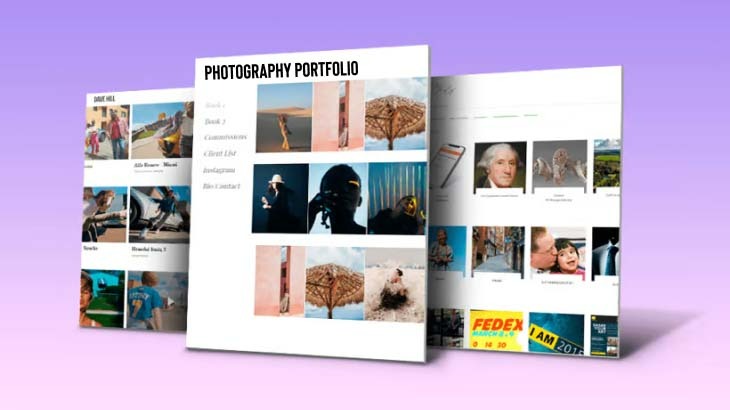Professional photography requires a lot of work. It's challenging to stand out in your field and develop a clientele when you're just getting started. The creation of a photographic portfolio is one of the finest strategies to draw in new customers. You need a collection that will catch their eye and cause them to pay attention. Current photographers have good collections, sets, and portfolios that appeal to a variety of picture purchasers going into the 2020s in addition to having strong individual photographs. They supply a wide range and quantity of photographs in addition to the greatest photos.
It might be challenging to put together a photographic portfolio. Most people intend to make one, and some even start gathering materials, but give up because they think their art is not good enough and do not know how to exhibit it properly. These easy steps should help you get started on creating your portfolio, which can be a helpful exercise. Creating a professional portfolio is a terrific method to showcase your distinct abilities and photographic style when meeting new customers or networking during photoshoots, whether you are already employed in the photography industry or are still developing your brand. Your photography studio may benefit greatly from the inclusion of a well-crafted photo album that features a sampling of the work you're most pleased with.
Here are 10 tips for making a Photography Portfolio in 2023 -
1. Be disciplined - Narrowing down your picture choices is frequently the most challenging step in developing a portfolio because it must be done before you can even consider the arrangement or theme. While it goes without saying that you should choose your best photos, you should also consider your readership and the abilities you want to highlight when choosing what to include. If you specialise in photographing buildings or real estate, for instance, you should pick pictures that show off your expertise in those areas. You might also divide the portfolio into several categories if you have a variety of specialties to show off, from events or product photography to portraits.
2. Your customer base - You must think about your target audience after deciding what you want your portfolio to accomplish. Try to think about the response you want to elicit; are you going for happiness, surprise, or shock? Try to make your photos stand out and elicit the response you desire since not everyone wishes to see your preferred panoramic photo or the same old generic photos they see every day. Customers want to observe how photographers understand and use trends. Develop your individual taste and hobbies, and don't compromise your individuality as an artist. Give clients something out of the ordinary to surprise them.
3. Focus on a simple design - If visitors to your portfolio website are consistently complimenting its aesthetic, something is most likely not right. Don't clog it up with unnecessary design elements because your photographs are meant to be the main attraction. A website is in trouble if visitors focus on its design rather than the photographs it offers. Less is more in terms of the design of your portfolio. It makes each piece stand out and have a stronger effect to leave some white space amongst photos such as between images and text. Consider using a delicate touch when adding watermarks if you must. Your viewers will be put off and distracted by excessively forceful watermarks.
4. When necessary, make captions accessible - Even if you could assume that a genuinely great shot doesn't even need a caption, every photo could benefit from some text-based information. It's a smart idea to have the information available for viewers in case they ever require it since some viewers might wish to learn concerning the image. Name, date, and method of creation, among other information. You can choose to keep this data invisible by default so that it doesn't become a distraction and only enables it when a user clicks or rolls over a button that says, "More Info."
5. Maintain objectivity - It's crucial to maintain objectivity while assessing your work when you're shooting for stock since you have a considerable amount of artistic licence. Think as a client, proofreader, or designer as you go through the editing process. Given that consumers consider several factors while viewing photographs, including layout and text space, it's possible that the most stunning image in your portfolio won't be the picture that sells the most. Think about if you might envision one of your pictures in an editorial or advertising. Providing consumers with several viewpoints and angles from a single session is a fantastic concept but curating and choosing just the finest images is crucial to avoid having a portfolio that is uniform or monotonous.
6. Ensure that everything is simple to link to - There should be a separate link url, or "page," for each image on your website. You should include links for users to post on their social media accounts when they visit your website to make it simple for them to spread the word about your content. Nothing is more annoying than an instruction-required portfolio. Most individuals won't put in the necessary time and effort if your presentation is difficult to link to and instead will simply move on.
7. The appropriate theme - The next thing you should do is decide on a theme or style for your portfolio. Your audience will choose how to do this. You should only submit your portrait photography if you are applying for a job. You may possess a collection of black-and-white or sepia photographs, images captured with a certain camera format, or images from a particular era or location. Ensure that you have a valid cause for changing the sorts and styles of photographs before you do so. Never forget that you should maintain a uniform colour scheme and level of quality across the whole body of work, regardless of the topic.
8. The way of demonstration is important - To get a response from viewers, the pictures' presentation is essential. You will be let down by a poorly organised collection of excellent photos that simply don't credit them. Be mindful of how borders, presentational strategies, and backing sheet colour can all be used to enhance the photographs. Whether the pictures are placed chronologically or to conjure a certain atmosphere, the sequence in which they are taken should also be taken into account. Avoid merely picking your favourite picture as the headline image. In your choice, try to convey the collection's spirit.
9. Make it genuine - Though portfolios formerly had a bad name for being cliche and stereotyped, today's clients are more receptive to work that is more genuine and real. Look for omissions in current media and consider how you may portray people in a way that is uplifting and meaningful. It is beneficial to have a solid grasp of how modern stock photography appears and how it might support the initiation of sincere discussions about diversity. There is a pull for more diverse and equitable representation, as well as visuals that are original and creative, and that incorporate marginalised tales.
10. Designs and styles - The style and layout of your portfolio should now be taken into account. Before you set out to buy something, think about what size you want your printed out photos to be. You'll need to have a folder or portfolio case to carry it all in. Next, choose the printing paper and quality, preferably the best you can buy. Despite this, keep in mind that there are no constraints on size, form, or style; the more personal and indicative of your artistic identity it is, the better. The type of paper you use will also affect the outcome of your photographic portfolio. For example, glossy photographic paper highlights detail and brings out colour brightness, which may be a wonderful choice for showcasing pet or wildlife pictures. A more artistic look is produced and factors like light and composition are highlighted when using matte photographic paper, which has a softer texture and doesn't reflect light.







Leave a reply